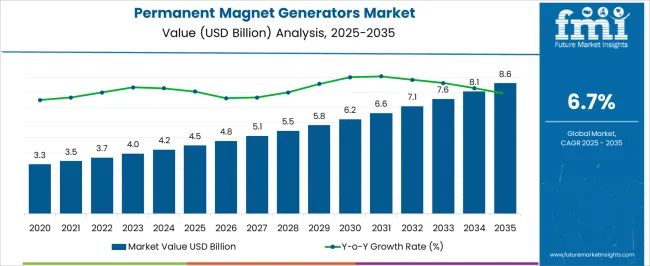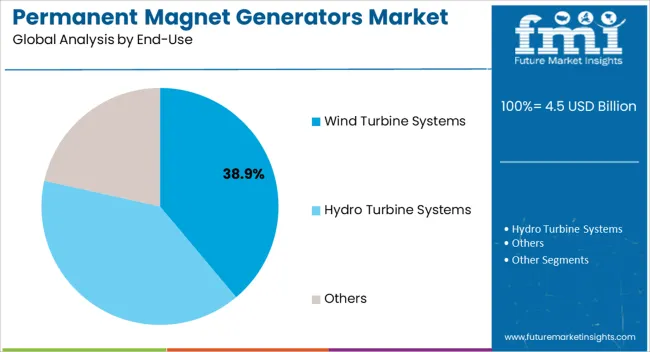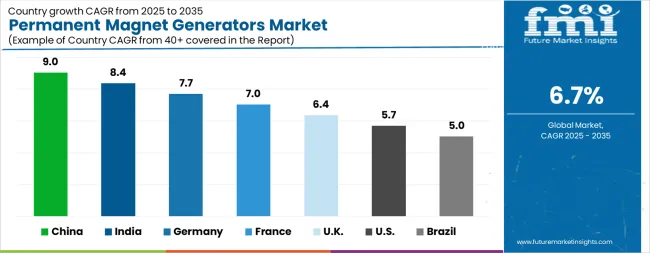The Permanent Magnet Generators Market is estimated to be valued at USD 4.5 billion in 2025 and is projected to reach USD 8.6 billion by 2035, registering a compound annual growth rate (CAGR) of 6.7% over the forecast period.

| Metric | Value |
|---|---|
| Permanent Magnet Generators Market Estimated Value in (2025 E) | USD 4.5 billion |
| Permanent Magnet Generators Market Forecast Value in (2035 F) | USD 8.6 billion |
| Forecast CAGR (2025 to 2035) | 6.7% |
The Permanent Magnet Generators market is witnessing significant growth, driven by the increasing demand for renewable energy generation and energy-efficient power conversion systems. The adoption of permanent magnet technology is being supported by its ability to provide high efficiency, reduced mechanical losses, and lower maintenance requirements compared to conventional generators. Rising investments in wind energy, microgrid installations, and distributed power systems are fueling market expansion.
Continuous advancements in magnetic materials, generator design, and power electronics are enhancing performance and reliability, making these generators suitable for both large-scale and decentralized energy applications. The shift toward sustainable energy policies, coupled with incentives for renewable energy deployment, is further accelerating adoption.
Growing awareness of carbon reduction targets and energy efficiency regulations is driving the need for generators that can deliver optimized performance under variable load conditions As the renewable energy sector continues to expand, Permanent Magnet Generators are expected to remain a key technology, supported by ongoing innovation in materials, efficiency enhancement, and integration with advanced energy systems.
The permanent magnet generators market is segmented by type of machine, speed, end-use, and geographic regions. By type of machine, permanent magnet generators market is divided into Permanent Magnet AC Generator and Permanent Magnet DC Generator. In terms of speed, permanent magnet generators market is classified into Low Speed PMG, Medium Speed PMG, and High Speed PMG. Based on end-use, permanent magnet generators market is segmented into Wind Turbine Systems, Hydro Turbine Systems, and Others. Regionally, the permanent magnet generators industry is classified into North America, Latin America, Western Europe, Eastern Europe, Balkan & Baltic Countries, Russia & Belarus, Central Asia, East Asia, South Asia & Pacific, and the Middle East & Africa.

The permanent magnet AC generator segment is projected to hold 52.4% of the market revenue in 2025, establishing it as the leading type of machine. Its dominance is being driven by high energy conversion efficiency, superior reliability, and the ability to operate under variable load conditions without significant performance loss.
The use of permanent magnets eliminates the need for external excitation systems, reducing operational costs and maintenance requirements. AC generators are widely adopted in renewable energy applications, particularly in wind turbines and small-scale hydro installations, due to their stable output and adaptability to grid requirements.
Continuous research in magnetic materials and generator design is enhancing durability, power density, and thermal performance, further reinforcing their market leadership The combination of cost-effectiveness, high efficiency, and broad applicability ensures that permanent magnet AC generators will continue to dominate the market, supported by ongoing investment in renewable energy infrastructure and technological innovation.

The low speed PMG segment is expected to hold 43.7% of the market revenue in 2025, making it the leading speed category. Growth is being driven by the widespread deployment of low speed permanent magnet generators in wind turbines, microgrids, and distributed power systems. These generators provide high efficiency at lower rotational speeds, reducing mechanical stress and minimizing maintenance requirements.
The ability to operate under variable wind or water flow conditions enhances reliability and ensures consistent power output. Advances in generator design, including optimized rotor and stator configurations, are improving performance and reducing energy losses.
Low speed PMGs also facilitate direct-drive systems, eliminating the need for gearboxes and further increasing system efficiency As renewable energy adoption grows and reliability remains a critical factor, the low speed PMG segment is expected to maintain its leadership, supported by increasing investments in wind turbine systems and sustainable energy infrastructure.

The wind turbine systems end-use segment is projected to account for 38.9% of the market revenue in 2025, establishing it as the leading end-use industry. Growth is being driven by the global expansion of onshore and offshore wind energy projects aimed at increasing renewable energy capacity and meeting decarbonization targets.
Permanent magnet generators are preferred in wind turbines due to their high efficiency, low maintenance, and ability to operate under variable wind speeds, enabling reliable and continuous power generation. Direct-drive PMG systems reduce mechanical losses and increase operational lifespan, further enhancing adoption in the sector.
Government incentives, renewable energy policies, and investments in sustainable power generation are reinforcing demand As wind energy continues to play a pivotal role in the transition to clean energy, the wind turbine systems segment is expected to remain the primary driver of growth in the Permanent Magnet Generators market, supported by technological innovation and increasing turbine installations worldwide.
The rate of consumption of conventional energy sources is expanding day by day. This has presented non-conventional energy sources as an alternative to traditional energy sources. Renewable energy sources, for example, wind, solar, biogas, small-scale hydro power plants, etc
. provide enhanced ecological protection. Declining fossil fuels supply and the damaged environment, which in some ways can be blamed on the conventional energy sources, have made it more important to discover other energy sources. Permanent magnet generators are becoming more popular day by day. They renewable are used to convert mechanical energy produced by rotor blades to electrical energy.
The energy conversion is based on Faraday’s laws of electromagnetic induction, that dynamically induces an electro-motive force i.e. e.m.f into the generators coils as it rotates. In permanent-magnets generators, permanent magnets are incorporated in the conventional rotor of an induction generator. Since these generators do not leave behind any residue or untreatable waste, they are fast becoming an extremely popular choice.
Permanent magnet generators are widely used in small wind turbines. These days, they are also being used in large offshore and onshore wind turbines.
These generators are superior replacements of traditional induction motors and can easily be attached with diesel generators, turbines and hybrid vehicles. These generators can also be utilized as part of wind as well as water machines. Some of the advantages of permanent magnet generators are self-protection against short circuits and severe overloads and easy maintenance.
The permanent magnet generators can be a direct current voltage machine with a rotary collector and brushes or an alternating current synchronous multiphase machine where the rotor and the stator magnetic fields are rotating at a similar speed. This removes the excitation losses in the rotor, which generally amount to 20% to 30% of the collective generator losses.
The reduced losses additionally give a lower temperature rise, which essentially means that a simpler and smaller cooling system can also be used in the generator. In case of permanent magnet AC synchronous generator, the inductor is located at the rotor whereas in permanent magnet DC generator, the inductor which consists of a coil or wire loop is set up at the stator with a group of permanent magnets.
In general, direct current permanent magnet generators are a preferred choice for wind turbine systems that operate at a small scale as they can work at low rotational speeds and give high degree of reliability with minimum maintenance costs. Their cut-in point is genuinely low and thus, they are also able to provide good proficiency particularly in light wind conditions.

| Country | CAGR |
|---|---|
| China | 9.0% |
| India | 8.4% |
| Germany | 7.7% |
| France | 7.0% |
| UK | 6.4% |
| USA | 5.7% |
| Brazil | 5.0% |
The Permanent Magnet Generators Market is expected to register a CAGR of 6.7% during the forecast period, exhibiting varied country level momentum. China leads with the highest CAGR of 9.0%, followed by India at 8.4%. Developed markets such as Germany, France, and the UK continue to expand steadily, while the USA is likely to grow at consistent rates. Brazil posts the lowest CAGR at 5.0%, yet still underscores a broadly positive trajectory for the global Permanent Magnet Generators Market. In 2024, Germany held a dominant revenue in the Western Europe market and is expected to grow with a CAGR of 7.7%. The USA Permanent Magnet Generators Market is estimated to be valued at USD 1.7 billion in 2025 and is anticipated to reach a valuation of USD 2.9 billion by 2035. Sales are projected to rise at a CAGR of 5.7% over the forecast period between 2025 and 2035. While Japan and South Korea markets are estimated to be valued at USD 204.1 million and USD 148.2 million respectively in 2025.

| Item | Value |
|---|---|
| Quantitative Units | USD 4.5 Billion |
| Type Of Machine | Permanent Magnet AC Generator and Permanent Magnet DC Generator |
| Speed | Low Speed PMG, Medium Speed PMG, and High Speed PMG |
| End-Use | Wind Turbine Systems, Hydro Turbine Systems, and Others |
| Regions Covered | North America, Europe, Asia-Pacific, Latin America, Middle East & Africa |
| Country Covered | United States, Canada, Germany, France, United Kingdom, China, Japan, India, Brazil, South Africa |
| Key Companies Profiled | Siemens AG, ABB Ltd., GE Renewable Energy, Mitsubishi Electric Corporation, Toshiba Corporation, Hitachi Ltd., Vestas Wind Systems A/S, Enercon GmbH, Gamesa Corporación Tecnológica, Suzlon Energy Limited, Senvion S.A., Goldwind Science & Technology Co., Ltd., Nordex SE, and Alstom S.A. |
The global permanent magnet generators market is estimated to be valued at USD 4.5 billion in 2025.
The market size for the permanent magnet generators market is projected to reach USD 8.6 billion by 2035.
The permanent magnet generators market is expected to grow at a 6.7% CAGR between 2025 and 2035.
The key product types in permanent magnet generators market are permanent magnet ac generator and permanent magnet dc generator.
In terms of speed, low speed pmg segment to command 43.7% share in the permanent magnet generators market in 2025.






Our Research Products

The "Full Research Suite" delivers actionable market intel, deep dives on markets or technologies, so clients act faster, cut risk, and unlock growth.

The Leaderboard benchmarks and ranks top vendors, classifying them as Established Leaders, Leading Challengers, or Disruptors & Challengers.

Locates where complements amplify value and substitutes erode it, forecasting net impact by horizon

We deliver granular, decision-grade intel: market sizing, 5-year forecasts, pricing, adoption, usage, revenue, and operational KPIs—plus competitor tracking, regulation, and value chains—across 60 countries broadly.

Spot the shifts before they hit your P&L. We track inflection points, adoption curves, pricing moves, and ecosystem plays to show where demand is heading, why it is changing, and what to do next across high-growth markets and disruptive tech

Real-time reads of user behavior. We track shifting priorities, perceptions of today’s and next-gen services, and provider experience, then pace how fast tech moves from trial to adoption, blending buyer, consumer, and channel inputs with social signals (#WhySwitch, #UX).

Partner with our analyst team to build a custom report designed around your business priorities. From analysing market trends to assessing competitors or crafting bespoke datasets, we tailor insights to your needs.
Supplier Intelligence
Discovery & Profiling
Capacity & Footprint
Performance & Risk
Compliance & Governance
Commercial Readiness
Who Supplies Whom
Scorecards & Shortlists
Playbooks & Docs
Category Intelligence
Definition & Scope
Demand & Use Cases
Cost Drivers
Market Structure
Supply Chain Map
Trade & Policy
Operating Norms
Deliverables
Buyer Intelligence
Account Basics
Spend & Scope
Procurement Model
Vendor Requirements
Terms & Policies
Entry Strategy
Pain Points & Triggers
Outputs
Pricing Analysis
Benchmarks
Trends
Should-Cost
Indexation
Landed Cost
Commercial Terms
Deliverables
Brand Analysis
Positioning & Value Prop
Share & Presence
Customer Evidence
Go-to-Market
Digital & Reputation
Compliance & Trust
KPIs & Gaps
Outputs
Full Research Suite comprises of:
Market outlook & trends analysis
Interviews & case studies
Strategic recommendations
Vendor profiles & capabilities analysis
5-year forecasts
8 regions and 60+ country-level data splits
Market segment data splits
12 months of continuous data updates
DELIVERED AS:
PDF EXCEL ONLINE
Permanent Magnet Integrated Air Compressor Market Size and Share Forecast Outlook 2025 to 2035
Permanent Magnet Motor Market Forecast Outlook 2025 to 2035
High Performance Permanent Magnet Market Size and Share Forecast Outlook 2025 to 2035
Magnetic Absorption Data Line Market Size and Share Forecast Outlook 2025 to 2035
Magnetic Material Magnetization and Testing Equipment Market Size and Share Forecast Outlook 2025 to 2035
Magnetic Coupler Market Size and Share Forecast Outlook 2025 to 2035
Magnet Buffer Market Size and Share Forecast Outlook 2025 to 2035
Magnetic Shielding Device Market Size and Share Forecast Outlook 2025 to 2035
Magnetic Stripe Readers Market Size and Share Forecast Outlook 2025 to 2035
Magnetic Resonance Analyzer Market Size and Share Forecast Outlook 2025 to 2035
Magnetic Drive Pump Market Size and Share Forecast Outlook 2025 to 2035
Magnetic Separator Market Size and Share Forecast Outlook 2025 to 2035
Magnetic Ballast Market Size and Share Forecast Outlook 2025 to 2035
Magnetic Sensor Market Size and Share Forecast Outlook 2025 to 2035
Magnetic Flowmeter Market Size and Share Forecast Outlook 2025 to 2035
Magnetic Resonance Imaging Coils Market Analysis - Size, Share, and Forecast 2025 to 2035
Magnetic Tape Market Analysis Size and Share Forecast Outlook 2025 to 2035
Magnetic Resonance Imaging (MRI) Contrast Agents Market Size and Share Forecast Outlook 2025 to 2035
Magneto Optic Current Transformer Market Size and Share Forecast Outlook 2025 to 2035
Magnetic Crack Detectors Market Size and Share Forecast Outlook 2025 to 2035

Thank you!
You will receive an email from our Business Development Manager. Please be sure to check your SPAM/JUNK folder too.
Chat With
MaRIA